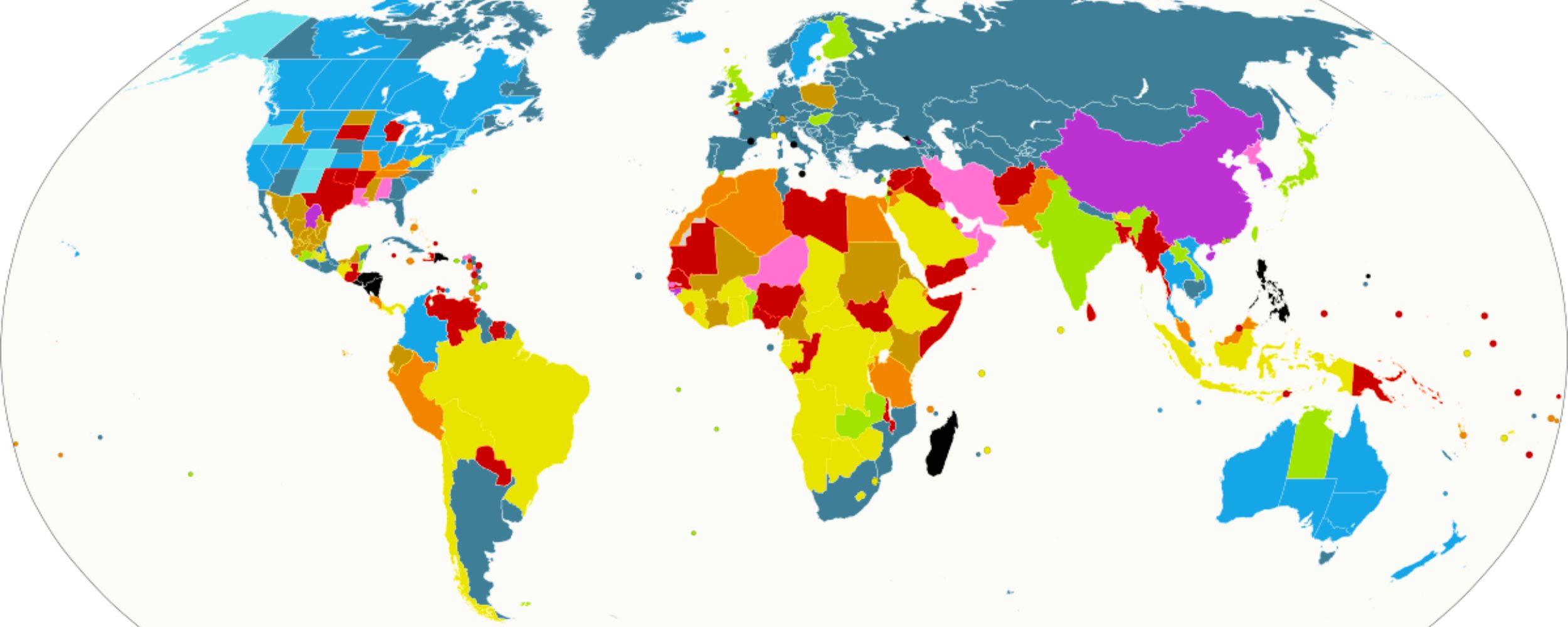- News >
- Countries with legal Abortion laws
Countries with legal Abortion laws

Currently, around 50 countries have embraced more liberal abortion laws, leading to improved access to abortions for women over the past few decades. While some countries have gradually implemented changes in their abortion legislation, others have made transformative modifications by eliminating all restrictions on abortion in support of women's reproductive rights. Nearly 90% of nations permit abortions, at least in cases where a woman's life is endangered by the pregnancy. Additional circumstances where abortions are allowed include situations where the woman's health is at risk during the pregnancy or in cases of rape or incest.
This article aims to provide essential information on abortion laws, including the countries where abortions are legal, prohibited, and permitted under specific circumstances. It also offers an overview of the current state of affairs regarding this topic.
How Abortion is perceived worldwide
Abortion laws vary across countries, but the majority allow abortion under certain circumstances. Globally, only 24 countries have a complete ban on abortion.
Over the past five decades, there has been a trend toward liberalising abortion laws, especially in developed nations. According to the World Health Organization (WHO), approximately 73 million abortions occur worldwide annually, resulting in an average of 39 abortions per 1000 women. This rate has remained relatively stable since 1990.
Notably, between 1990-1994 and 2015-2019, countries with generally legal abortions (excluding China and India) experienced a 43% decline in the average abortion rate. In contrast, countries with severe abortion restrictions saw an average increase of around 12%.
In many developed countries, abortion laws allow for unrestricted access. However, approximately 100 countries have some restrictions in place, usually permitting abortion only in specific circumstances. These circumstances may include socioeconomic factors, risks to the woman's physical or mental health, or foetal anomalies. However, the legal language regarding foetal impairment is often vague, which can create uncertainty for medical professionals in determining the legality of certain abortions.
International frameworks, such as the UN Human Rights Committee and regional human rights courts like the European Court of Human Rights, the Inter-American Court of Human Rights, and the African Commission on Human and People's Rights, have recognized access to safe abortions as a human right.
A significant milestone in this area was the 1994 International Conference on Population and Development held in Cairo, where 179 governments endorsed a program of action that emphasised preventing unsafe abortions. The WHO had previously acknowledged unsafe abortion as a public health issue in 1967, and in 2003, it developed guidelines recommending that abortion laws protect women's health.
The UN Population Fund has addressed the unmet need for family planning as a means to safeguard maternal life, reduce maternal mortality, and potentially decrease abortions by up to 70% in developing countries.
Recent shifts concerning Abortion
Recent trends globally indicate a movement towards the liberalisation of abortion laws. Since 2000, 38 countries have made changes to their abortion legislation, with all but one, Nicaragua, expanding the legal grounds for women to access abortion services.
Notable examples of recent developments include Argentina and Thailand legalising abortions with certain gestational limits, South Korea and Mexico decriminalising abortions, New Zealand easing its abortion restrictions, and Colombia allowing abortion up to 24 weeks of pregnancy.
Despite the overall trend towards greater reproductive rights for women, some countries, such as the United States, are bucking this trend by implementing policies to tighten abortion restrictions.
US perception on Abortion

Let's focus on recent developments regarding abortion in the United States, particularly the Supreme Court decision on June 24, 2022, overturning Roe v. Wade after nearly 50 years, where the right to have an abortion was established as a constitutional right. Previously, the Constitution guaranteed the right to choose to have an abortion, with some regulations imposed after the first trimester of pregnancy. With this ruling, the United States joined other European nations as one of the early adopters of liberalised abortion laws. In 1992, the Planned Parenthood v. Casey's case reaffirmed a woman's right to abortion but also allowed for certain restrictions like waiting periods and parental consent.
Abortion laws have varied across states in the US, and over the years, states have introduced and enforced diverse laws to regulate abortions. While some states have protected abortion access, others have implemented regulations on abortion providers and attempted to prohibit abortion at earlier stages of pregnancy. Consequently, around 160 clinics closed, leaving some states with only one abortion provider. In recent times, numerous states have passed increasingly stringent abortion laws, such as Oklahoma, where the governor signed legislation banning all abortions after six weeks, except in cases of life-threatening pregnancies. This law resembles one passed in Texas in 2021, where private citizens can sue anyone suspected of providing or facilitating an abortion.
The reversal of Roe v. Wade allows the 13 "trigger states" to automatically ban abortion or within a 30-day period. While these state laws generally exempt abortions in cases of life-threatening pregnancies, many do not exempt pregnancies resulting from rape or incest. Anti-abortion advocates have applauded the Supreme Court's decision to overturn Roe v. Wade, while Democratic lawmakers and abortion advocates have condemned the ruling.
Health care and Abortion
As abortion laws have become more progressive in many countries, there has been a corresponding improvement in the quality, safety, and maternal outcomes of abortion procedures.
However, the safety of abortions varies significantly depending on a country's legal stance on the procedure. In countries where abortion is generally legal, almost 90% of abortions are considered safe. In contrast, in countries where abortion is heavily restricted or banned, only 25% of abortions are considered safe.
The World Health Organization (WHO) has reported that approximately 5-13% of maternal deaths worldwide are due to complications from unsafe abortions, with the majority occurring in developing countries.
While some countries have made significant strides in progressive abortion legislation, there has been staunch opposition in certain areas. Recently, several countries, particularly those with autocratic governments, have moved to restrict pro-abortion rights and women's reproductive rights. This opposition was evident in the June 2022 victory where the US Supreme Court overturned the long-standing 1973 decision of Roe v. Wade, which had guaranteed constitutional rights to abortion for almost 50 years.
Countries that have made abortion legal
According to the Center for Reproductive Rights, abortion is legal in most countries around the world. However, the gestational time limits and other restrictions vary from country to country. In some countries, abortion is covered by most health insurance plans. There are also organisations that provide emotional support and information on the procedure to women who are considering having an abortion.
The table you provided lists 55 countries where abortion is legal. It is important to note that this list is not exhaustive, and there may be other countries where abortion is legal. It is also important to note that the laws on abortion can change, so it is always best to check with the latest regulations in the country where you are seeking an abortion.
Countries that have legalised abortion only on socio economic terms
Some countries allow abortion if the woman's social and economic situation makes it difficult or impossible for her to carry a pregnancy to term. These countries include Barbados, India, Belize, Japan, Ethiopia, Rwanda, Fiji, Saint Vincent and the Grenadines, Finland, Taiwan, Great Britain, Zambia, and Hong Kong.
The specific criteria for allowing abortion on socioeconomic grounds vary from country to country. In some countries, abortion may be allowed if the woman is unable to afford to raise a child, or if she is in a situation where pregnancy would put her at risk of financial hardship or social isolation. In other countries, abortion may be allowed if the woman is unable to continue her education or employment due to pregnancy.
Countries that have legalised abortion only on risky situations
The following countries allow abortion if the woman's life is at risk. This means that if the pregnancy poses a serious threat to the woman's physical or mental health, she may be able to have an abortion. The specific criteria for allowing abortion on this basis vary from country to country.
The list you provided includes 31 countries where abortion is legal if the woman's life is at risk. It is important to note that this list is not exhaustive, and there may be other countries where abortion is legal on this basis. It is also important to note that the laws on abortion can change, so it is always best to check with the latest regulations in the country where you are seeking an abortion.
Here are some additional things to keep in mind about abortion laws in countries that allow abortion when the woman's life is at risk:
- The woman may need to obtain consent from a medical professional before having an abortion.
- The abortion may need to be performed by a qualified doctor.
- The abortion may need to be performed in a hospital or other medical facility.
Countries that do not allow the act of aborting

There are 24 countries in the world where abortion is completely prohibited. These countries include Andorra, Haiti, Malta, Senegal, Congo (Brazzaville), Honduras, Mauritania, Sierra Leone, Curaçao, Iraq, Nicaragua, Suriname, Dominican Republic, Jamaica, Palau, Tonga, Egypt, Laos, Philippines, West Bank & Gaza Strip, El Salvador, Madagascar, and San Marino.
The World Health Organization (WHO) has reported that there is little to no correlation between global abortion rates and whether abortion is legal in a specific country. This means that abortion rates are similar in countries where abortion is legal and in countries where it is illegal.
However, the safety of abortions is impacted by their legality. In countries where abortions are illegal, women who have abortions are more likely to experience complications, including death.
The Center for Reproductive Rights has stated that while 970 million women, or 59% of women of reproductive age, live in countries where there are lax restrictions on abortions, 41% of women do not have access to abortions. 700 million women of reproductive age are impacted by not having access to safe and legal abortion services.
FAQ
Which countries in Latin America have legalized abortion?
In Latin America, which countries have legalized abortion? Argentina legalized abortion on 29 December 2020. Cuba has allowed abortions since 1965, and Guyana since 1995. Uruguay legalized abortion in 2012, and French Guiana, as part of France, legalized it in 1975.
How many countries have restrictions on abortion?
Which countries have restrictions on abortion? There are 24 nations worldwide that completely prohibit abortion. In Europe, these countries are Andorra and Malta. In Africa, Senegal and Egypt have restrictions, and in Asia, the Philippines and Laos have strict laws against abortion.
